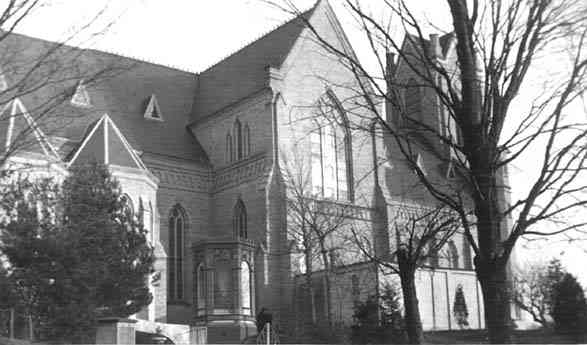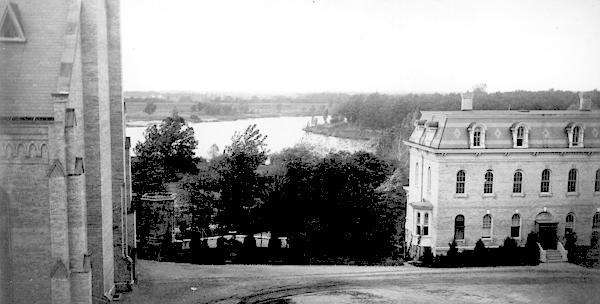
Notre Dame's Grotto / by Dorothy V. Corson


Sorin Builds First Grotto at Notre Dame in 1878
During the years 1876 and 1877, no major events related to the Blessed Virgin or the Grotto were recorded. Then references to an early Grotto being built by Sorin appeared in several 1878 entries. One entry, which confused Sorin's 1878 grotto with the present one, reported it had taken 18 years to build and was completed in 1896. The present Grotto was completed in three months.
A few earlier mentions of work in process on Sorin's Grotto were published in the September 29, 1877 Scholastic:
It is the intention of Father Sorin to erect a facsimile of the original [Lourdes Grotto] with the exception of the immense rock 200' high. The hill at the rear of the church presents every advantage for a facsimile which he wishes to reproduce with scrupulous exactness as regards, height, length, depth etc. Ever since his first visit to Lourdes in 1873 his resolution to satisfy the wishes of pious pilgrims and visitors in this respect has constantly increased. Being there is quite a concourse of pilgrims at Notre Dame from time to time the facsimile of the wonder-working Grotto cannot fail to be an object of attraction to all who visit the place.(52)
Scholastic : April 6, 1878
Work on the imitation of the Grotto Of Lourdes, just to the Northwest of the new church has commenced in a little wooded dell regarded as one of the charming spots at Notre Dame.(53)
The dedication of an earlier Grotto built by Sorin was reported in the Scholastic on August 22, 1878.(54) It was a brief entry. No description of the ceremony was included.
More paging through the Scholastics revealed that two days before the 1896 dedication of the present Grotto, the Scholastic reported:
Removal of tower-like niche which sheltered Blessed Virgin on site of old Grotto was effected, after the statue had been placed in the new Grotto. When [the] statue was taken away the niche meant nothing and was a disfigurement.(55)
If the statue fit in the new Grotto then the old Grotto niche must have been similar in size to the present one, but why were there no pictures of it?
A folder in the University Archives contained an article written for the Columbian Jubilee Celebration in 1892. It included a brief description of an earlier Grotto built at Notre Dame by Sorin in 1878.
As we leave the Seminary grounds and turn eastward toward the University, our path lies along the shore of St. Mary's Lake, on the opposite bank of which we see the barns, stables, and numerous small buildings that constitute the "home center" of the great farm.
Our path has now led us to the foot of a little hill, and we are agreeably surprised, as we are brought face to face with a facsimile representation of the Grotto of Lourdes, beautifully sculptured out of the side of the declivity. The rocks are there portrayed, while underneath is the gurgling fountain. To one side, lifted on high, is a beautiful statue of Our Lady of the Immaculate Conception, encased in an octagonal frame, the sides of which are glass, supported by stone pillars. At a little distance is the kneeling figure of Bernadette, in her quaint, pleasing Breton dress, praying to the Virgin of the Apparitions. To the left of this lovely spot is a square, three-story building -- the residence of Very Rev. Father General Sorin and his assistants. It is the mother house of the entire Congregation of Holy Cross -- the great center whence issue those directions that regulate the affairs of the order extended over the world. Such are some of the principal features of Notre Dame -- the Pride of the West . . . .(56)
This octagonal building description of Sorin's 1878 Grotto, in turn, registered as a building. The Sanborn maps of the 1880s, which had drawings of buildings on the campus, showed a small circle, labeled Grotto, in the corner of the church and sacristy. Since only buildings were indicated on the Sanborn maps, a cave-like Grotto like the present 1896 Grotto would not have been noted on them.

Thomas Schlereth's 1976 book(57) on the history of the campus included photographs from the 1880s showing the church and presbytery before the chapels were added. One photograph showed just the top of an odd shaped building. It had to be the octagonal building referred to in the "Jubilee" article. Unfortunately, the photo was too indistinct to view clearly, even with a magnifying glass.
A more intense search through the archival photographs of the church and presbytery grounds finally turned up a photograph that had gone unnoticed before. A large picture(58) of the front of the Sorin Grotto, dated November 22, 1886! It was between the presbytery and the church, about ten feet from the present sacristy steps, rather than at the bottom of the hill where the present Grotto is now. Subsequently, it has turned out to be the only clear photograph in existence depicting Sorin's Grotto, the first one built at Notre Dame. It is the photograph at the beginning of this chapter.
This photograph pinpointed the exact location of the octagonal building, its size, and how far away it was from the present Grotto. Unfortunately, the photograph was cropped leaving out the area below it. There were no photographs of the lower part of Sorin's original Grotto to show what it looked like. The photograph showed only what must have been a cement representation of the arch of the Grotto cave, below and to the left side of the "octagonal frame." The written description of the portion that was not visible, "the rocks are there portrayed, while underneath is the gurgling fountain," would seem to indicate it was not the exact replica of the Lourdes Grotto Sorin intended it to be.
The words "tower niche" and the fact that it was removed because "it no longer served a purpose" were now explained. What had been referred to as a "tower niche" was this quite large octagonal, glass-enclosed building.
Until his death in October of 1893, Sorin viewed his Grotto and gardens from the windows of his presbytery rooms. His windows faced south toward the Grotto and the sacristy, and west toward the garden area, which would now be the top of the present Grotto. A hedge of evergreens bordered this elaborate garden. On the other side of the hedge the present Grotto cave was carved from a small hill that faced St. Mary's Lake. This new location proved to be the ideal spot for it.
Father Sorin speaks of his 1878 Grotto in one of his Circular Letters written on board the "St. Germaine" on his way home from France. It was written on June 4, 1883.
Then, again, I wished in real eagerness to convey to you something of my petitions, and thanks, and tears of happiness, as your representative at the Grotto of Lourdes for the more than three days that we spent there, undisturbed, alone with her! Yes: alone with her! and yet with everyone in turn of the dear family, and at times with the entire little family; and she, from the celebrated Rock, looking down attentively and motherly upon each and all, and that usually four times a day, and from one to three hours each time. Never can I forget this fourth pilgrimage to the Immaculate Mother. . . . Two hours before we left, 8,000 men had arrived from distant points, and were on their knees, in earnest supplication before their Heavenly queen; 25,000 are often seen at a time in the same act of devotion; a million, at least are expected this year. Hundreds of miracles will probably be the result and the reward of this universal and ever-increasing piety. May Heaven be praised for this glorious and saving sign among us poor mortals!
It must be a great consolation for us at Notre Dame to possess such a neat and exact fac-simile of the real Grotto of Lourdes. I will visit it oftener than I ever did, and hope many others will do the same. Dear Brother Vincent, you will come and join me there, on fine days, will you not? You know Lourdes; you will show us how much you love it . . . .(59)